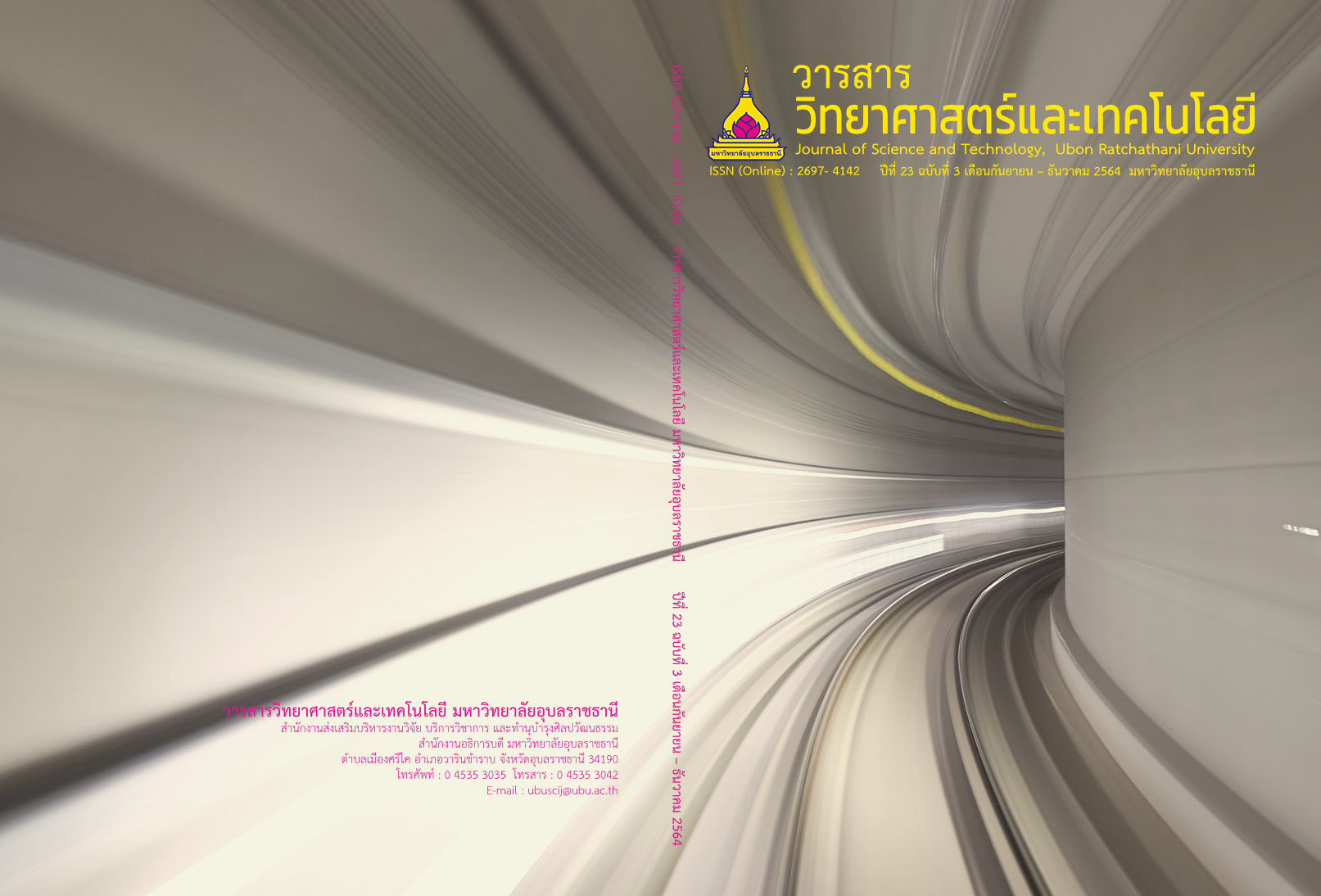การเพิ่มศักยภาพของพริกกะเหรี่ยงด้วยการพัฒนาพริกแกงเขียวหวานสูตรพริกกะเหรี่ยง
Main Article Content
บทคัดย่อ
พริกกะเหรี่ยงนิยมปลูกมากในกลุ่มชาติพันธุ์กะเหรี่ยง มีกลิ่นหอม มีรสเผ็ดสูง และอุดมด้วยสารแคปไซซิน ผลิตภัณฑ์พริกกะเหรี่ยงของชุมชนเขาโจดมีเพียงพริกสดและพริกแห้ง งานวิจัยนี้จึงต้องการพัฒนาพริกแกงเขียวหวานสูตรพริกกะเหรี่ยง เพื่อเพิ่มศักยภาพการใช้ประโยชน์ของพริกกะเหรี่ยง ทั้งนี้พริกกะเหรี่ยงที่ปลูกมากในพื้นที่เขาโจดมี 2 สายพันธุ์ กำหนดรหัสเป็น KJ1 และ KJ2 มีแคปไซซิน 1,537.72 มิลลิกรัมต่อกิโลกรัม และ 727.88 มิลลิกรัมต่อกิโลกรัม ตามลำดับ อัตราส่วนการใช้พริกกะเหรี่ยง KJ1, KJ2 และพริกขี้หนู ได้แก่ 2:2:0, 1:1:2 และ 2:1:1 เปรียบเทียบกับสูตรอ้างอิง (0:0:4) ผลการประเมินความพึงพอใจโดยผู้บริโภค 30 คน พบว่า พริกแกงและน้ำแกงสูตร 2:1:1 ได้รับความพึงพอใจทุกด้านสูงที่สุด ด้วยคะแนนที่สูงกว่าหรือเท่ากับสูตรอ้างอิง ซึ่งพริกแกงได้รับคะแนนความพึงพอใจโดยรวม สี เนื้อสัมผัส และกลิ่น เท่ากับ 4.8+0.6 4.7+0.4 4.7+0.6 และ 4.2+0.8 ตามลำดับ พริกแกงมีสีเขียว มีค่า L* และ a* เท่ากับ 37.8+1.7 และ 10.3+1.8 น้ำแกงมีความเผ็ดอยู่ในอันดับ 2 รองจากสูตร 2:2:0 แต่คะแนนความพึงพอใจโดยรวมมากที่สุด (4.6+0.6) ดังนั้นจึงควรสนับสนุนให้พัฒนากระบวนการผลิตพริกแกงเขียวหวานสูตรพริกกะเหรี่ยงในเชิงพาณิชย์ ร่วมกับการสนับสนุนให้มีการตรวจสอบและอนุรักษ์สายพันธุ์พริกกะเหรี่ยงที่เหมาะสมสำหรับเป็นวัตถุดิบพริกแกง
Article Details
บทความที่ได้รับการตีพิมพ์เป็นลิขสิทธิ์ของ วารสารวิทยาศาสตร์และเทคโนโลยี มหาวิทยาลัยอุบลราชธานี
ข้อความที่ปรากฏในบทความแต่ละเรื่องในวารสารวิชาการเล่มนี้เป็นความคิดเห็นส่วนตัวของผู้เขียนแต่ละท่านไม่เกี่ยวข้องกับมหาวิทยาลัยอุบลราชธานี และคณาจารย์ท่านอื่นๆในมหาวิทยาลัยฯ แต่อย่างใด ความรับผิดชอบองค์ประกอบทั้งหมดของบทความแต่ละเรื่องเป็นของผู้เขียนแต่ละท่าน หากมีความผิดพลาดใดๆ ผู้เขียนแต่ละท่านจะรับผิดชอบบทความของตนเองแต่ผู้เดียว
เอกสารอ้างอิง
Siripongvutikorn, S. and et al. 2008. Development of green curry paste marinade for white shrimp (Litopenaeus vannamei). Songklanakarin Journal of Science and Technology. 30(Suppl.1): 35-40.
Sirison, J., Jantapun, T. and Puechkamut, Y. Consumers’ acceptance of chicken green curry with soymilk in Bangkok. Journal of Science and Technology, Ubon Ratchathani University. 17(2): 29-35.
Khanthapok, P. and Sukrong, S. 2019. Anti-aging and health benefits from Thai food: Protective effects of bioactive compounds on the free radical theory of aging. Journal of Food Health and Bioenvironmental Science. 12(1): 54-67.
Weerawatanakorn, M. and et al. 2015. Fortification of calcium in Thai green curry paste. Food and Applied Bioscience Journal. 3(2): 85-99.
Rattanapaen, A. and et al. 2010. Development of dried red and green curry cube. Food. 40(3): 249-257. (in Thai)
Hwanji, S. and et al. 2020. Chandi prigkang: Development guidelines for the product standard of curry paste in community. Journal of Social Science and Cultural. 4(2): 45-63. (in Thai)
Lerdkasemphol, C. and et al. 2016. Determinants of the certified Thai community product standard of small and micro community enterprise groups in Samut Sakhon province, Thailand. International Journal of Agricultural Technology. 12(7.2):1785-1795.
Srewitoon, C., Kaewsom, C. and Sriphon, T. 2019. Systematic product development for chili paste in Ban Than-Om community, Thung Tako district, Chumphon province. University of the Thai Chamber of Commerce Journal, Humanities and Social Sciences. 39(3): 56-74. (in Thai)
Kongtoom, R., Insiripong, N. and Phaktanakanok, K. 2019. Partial characteristics study on native chili (Karen chili) planting in the western region of Thailand. In: Proceedings of the 4th Suan Sunandha National and International Academic Conference on Science and Technology, 8 November 2019. Bangkok, Thailand. (in Thai)
Crapnell, R.D. and Banks, C.E. 2021. Electroanalytical overview: The pungency of Chile and chili products determined via the sensing of capsaicinoids. Analyst. 146: 2769-2783.
Nantakornsuttanan, N. and et al. 2014. Antioxidant activities and total phenolic contents from different varieties of chili peppers extracts. Agricultural Science Journal. 45(2)(Suppl.): 365-368. (in Thai)
Subanmanee, N. 2020. Properties of pre-gelatinize jackfruit seed flour in Thai glutinous rice balls (Bua loi). Journal of Science and Technology, Ubon Ratchathani University. 23(1): 61-70. (in Thai)
Nagy, Z. and et al. 2017. Impact of shading net color on phytochemical contents in two chili pepper hybrids cultivated under greenhouse conditions. Horticultural Science and Technology. 35(4): 418-430.
Ahmed, J., Shivhare, U.S. and Singh, G.D. 2000. Chlorophyll and color of green chili puree as affected by mesh size and temperature. International Journal of Food Properties. 3(2): 305-315.
Thongmarong, P. and Phoomyai, P. 2017. Determination of capsaicin and antioxidant activity in spicy herbs. In: Proceedings of the 4th National Research Conference of Kamphaengphet Rajabhat University, 22 December 2017. Kamphaengphet, Thailand. (in Thai)
Yang, F. and Zheng, J. 2017. Understand spiciness: mechanism of TRPV1 channel activation by capsaicin. Protein Cell. 8(3): 169-177.


